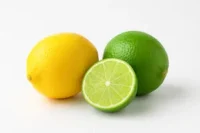“Understand Onion Growth Stages: Tips for Better Harvests”
Published: 22 Jan 2025
Are you unsure about what to expect during the different onion growth stages? Knowing when and how onions grow can make all the difference in achieving a successful harvest. From the first sprout to the moment you pick your onions, each stage requires attention to specific care needs. This post will break down each stage to help you understand exactly what happens and how to make the most of every phase.

Introduction of Onion Growth Stages
Onions have five growth stages: seed germination, vegetative growth, bulb formation, bulb maturation and onions harvesting. The seed absorbs water and swells during germination, breaking through the seed coat.
In vegetative growth, the onion plant grows leaves and a stem, with the first bulb forming below the soil. As the bulb grows, it pushes through the soil and matures into a fully formed onion. The onion is ready to harvest when the outer layers of the bulb are dry, and the stem has withered.
Seed Germination
The first stage in the onion growth cycle is seed germination, where the dormant seed grows and develops into a seedling. This stage is critical as it sets the foundation for growth. Seed absorbs water and nutrients during germination from the soil, activating the embryo inside to sprout. The initial root, called the radicle, emerges first, followed by the tiny shoot that will grow into the onion plant.
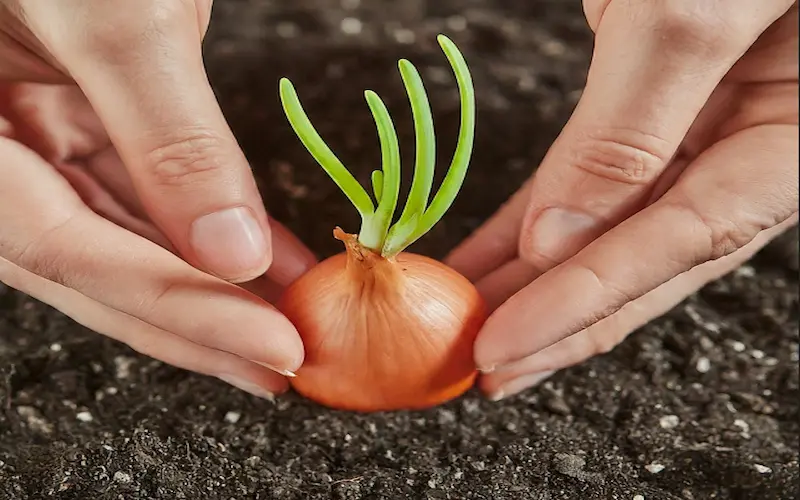
Optimal Conditions for Germination
Certain conditions are preferable for successful germination.
Temperature: Onion seeds germinate best between 68–77°F (20–25°C). Temperatures below 50°F may slow the process, while excessive heat can inhibit germination.
Soil: loose, well-draining, and rich in organic matter soil is preferable. A fine-textured seedbed ensures good seed-to-soil contact, which is crucial for germination.
Moisture: Consistently moist soil is necessary for germination. Overwatering causes the seeds to rot, while dry soil can prevent germination.
High-quality seeds: Always use high-quality seeds from a trusted source. Fresh seeds have a higher germination rate than older ones.
Seedling Development
Once the seeds germinate, the onion plants enter the seedling development stage, where small, green shoots begin to emerge from the soil. This stage is crucial for establishing vigorous, healthy plants that eventually form bulbs. Proper care during this phase lays the groundwork for a successful harvest.
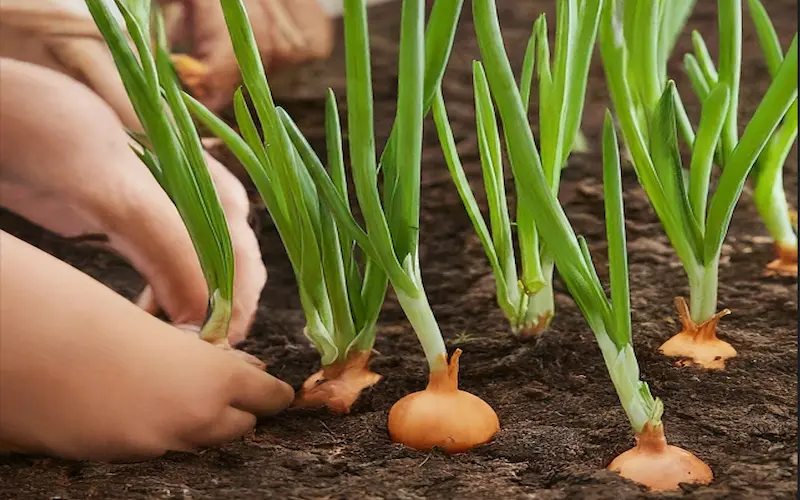
Characteristics of Onion Seedlings
The first visible sign of seedling growth is the emergence of thin, grass-like green shoots from the soil.
Seedlings are delicate and typically grow upright, reaching a height of about 2-3 inches in their early stages.
The roots grow deeper into the soil, anchoring the plant and absorbing essential nutrients and water.
Importance of Proper Spacing and Watering
Spacing: Seedlings need adequate space to grow without competing for nutrients, sunlight, or water. Crowded plants become weak and stunted. Maintain a 4-6 inches spacing between plants and 12-18 inches between rows during transplant seedlings. Proper spacing ensures good air circulation, reducing the risk of diseases.
Watering: Young seedlings require consistent moisture to thrive. Water them gently and regularly, ensuring the soil stays moist.
By monitoring your seedlings closely and addressing issues promptly, you can ensure they develop into vigorous, healthy plants ready for the next growth stage. Providing the right environment, water, and care at this stage significantly impacts the overall success of your onion crop.
Vegetative Growth
When onion plants focus on producing leaves and building their energy reserves is called the vegetative growth stage. Healthy leaf development during this stage is crucial, as the leaves are responsible for photosynthesis, which provides energy for bulb formation. Proper care during this stage ensures the plants are strong and capable of supporting the following stages of growth.

Focus on Leaf Development and Photosynthesis
During the vegetative stage, onion plants produce long, hollow, tubular leaves that are bright green. The number and size of leaves directly influence the size of the bulbs, as each leaf contributes to one layer of the bulb.
Photosynthesis occurs in the leaves, where sunlight is converted into energy. This energy is stored in the bulb and used for growth. Ensuring the leaves remain healthy and free of pests is vital for optimal energy production.
Onions are sensitive to sunlight and require at least 12-14 hours of light daily during this stage to perform photosynthesis efficiently.
Nutrient Requirements
Nitrogen is the key nutrient required during vegetative growth. It promotes lush green leaf development, which is critical for photosynthesis.
Apply a nitrogen-rich fertilizer, such as urea or ammonium nitrate, every two to three weeks. Avoid over-fertilizing, as excessive nitrogen can delay bulb formation.
Other nutrients like phosphorus and potassium are also essential but in smaller quantities. They support root development and overall plant health.
By focusing on healthy leaf growth and managing pests effectively during the vegetative stage, you set the foundation for vigorous plants and more prominent, healthier bulbs. Proper nutrition, regular monitoring, and timely interventions are key to success in this critical growth phase.
Bulb Formation
Bulb formation is called bulb formation when the plant starts transitioning its energy from leaf production to bulb development. It is one of the most critical phases in onion growth. During this stage, the onion plant utilizes the food reserves it has stored through photosynthesis to form and enlarge the bulb. Proper care at this stage is crucial to achieving large, healthy onions.
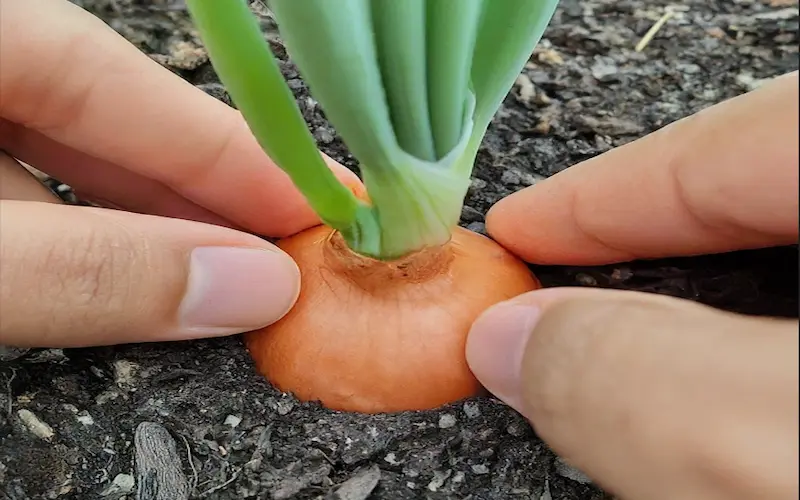
How Onions Start Forming Bulbs
The process of bulb formation begins when the plant senses environmental signals, particularly changes in daylight length (photoperiod).
As the onion grows, each leaf corresponds to a layer in the bulb. The more leaves an onion plant has during the vegetative stage, the larger the bulb.
During this stage, the base of the plant starts to swell and form the recognizable bulb shape. The plant shifts its energy from growing new leaves to enlarging the bulb.
Role of Daylight Length (Photoperiod) in Bulb Development
The length of daylight plays a significant role in determining when an onion plant will begin forming bulbs. Onions are classified into different types based on their photoperiod requirements:
Long-Day Onions:
Require 14-16 hours of daylight to initiate bulb formation.
It is commonly grown in northern regions with longer summer days.
Examples include varieties like ‘Walla Walla’ and ‘Yellow Spanish.’
Short-Day Onions:
Need only 10-12 hours of daylight to start bulb formation.
Typically grown in southern regions with shorter days in the growing season.
Popular varieties include ‘Texas Super Sweet’ and ‘Red Creole.’
Day-Neutral Onions:
These onions are less dependent on photoperiod and can grow in a broader range of regions.
It is ideal for gardeners unsure of their area’s daylight length.
Examples include ‘Candy’ and ‘Super Star.’
Farmers and gardeners must choose the right onion variety based on their region’s daylight conditions to ensure successful bulb formation. Planting the wrong type can result in poor or delayed bulb development.
Bulb Maturation
The final stage of onion growth is bulb maturation, where the onions reach full size and prepare for harvest. This is a crucial phase that determines the quality of your onion crop. Proper care during this stage ensures the onions are mature, healthy, and ready to store for long periods.
Signs of Maturity
As onions reach full maturity, the plant’s energy shifts entirely to the bulb, and the leaves show visible signs of ageing. The leaves start to yellow, wilt, and dry out. This is a natural part of the plant’s lifecycle, signalling that the bulbs have reached their final growth stage.
Papery Skin Formation: The outer skin of the onion bulb begins to dry and form a protective, papery layer. This layer helps to preserve the bulb during storage.
Neck Softening: The neck (the part of the onion where the leaves are attached to the bulb) begins to soften and collapse as the plant dries out, further signalling that the onion is nearing full maturity.
These visible changes tell you that the onions are in the process of completing their growth cycle. However, waiting until the plant shows all the signs of maturity is essential to ensure the bulbs have reached their full potential.
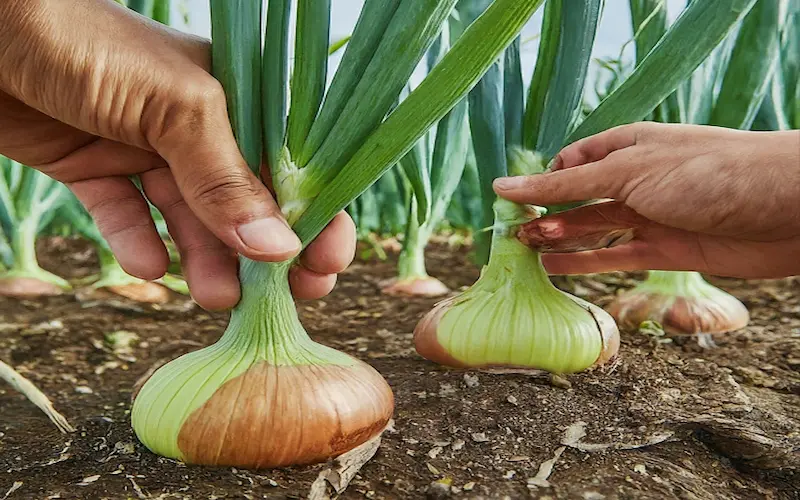
Harvesting and Post-Harvest
The final stage in the onion-growing process is harvesting and post-harvest management. This stage is crucial for ensuring your onions remain in good condition for long-term storage and use. Proper harvesting, curing, and storage can significantly impact your onions’ shelf life and overall quality. Here’s how to handle this stage correctly.
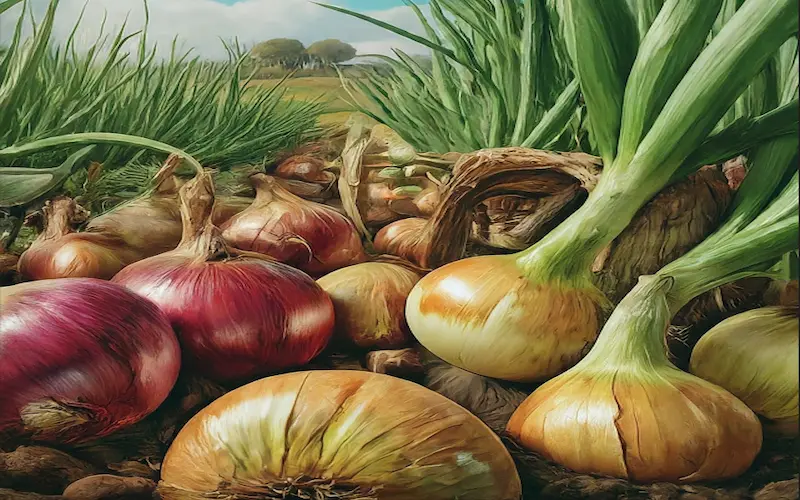
How to Harvest Onions Properly
Harvesting onions at the right time and with the proper technique is essential for preserving their quality. Follow these steps for a successful onion harvest:
Check for Maturity: Before harvesting, ensure the onions show all the signs of maturity—yellowing and wilting leaves, dry papery skins, and collapsed necks. Harvesting too early can result in underdeveloped bulbs, while waiting too long can lead to rotting or sprouting during storage.
Loosen the Soil: To avoid damaging the bulbs, gently loosen the soil around the onions using a fork or shovel. This will make it easier to pull them up without causing harm. Be careful not to puncture or bruise the bulbs.
Pulling the Onions: Grasp the onion’s neck firmly and pull it gently out of the ground. You can also use a digging fork to lift the onions out. Avoid pulling too hard, as this can cause the onion skins to tear or the bulb to break.
Handling with Care: After harvesting, hold the onions carefully to avoid damaging the bulbs. Bruising or scraping the skin can reduce its shelf life.
Common Challenges in Onion Growth
Onion farming, like any agricultural practice, comes with its share of challenges. Understanding and addressing these common issues can help ensure a healthy, productive onion crop. This section will discuss some of the most frequent challenges onion growers face and the practical solutions to tackle them.
Pests and Diseases
Pests and diseases are one of the most common challenges in onion farming. They can damage the plants at different stages of growth, affecting both the yield and quality of your crop.
Common Issues
Onion Maggots: Onion maggots are a significant pest that targets onion crops. The larvae of these flies burrow into the onion bulbs, causing them to rot. Onions that are damaged by onion maggots are prone to fungal infections and rot, resulting in poor-quality bulbs that are unsuitable for storage.
Fungal Infections: Fungal diseases such as downy mildew, white rot, and neck rot are common in onions. These infections can spread quickly in damp or humid conditions, causing the onion plant to wilt, the bulbs to decay, or the necks to rot. White rot, for instance, causes a soft, mushy texture in the bulbs, while downy mildew appears as yellow or purple spots on the leaves.
Thrips: Thrips are tiny insects that feed on onion plants by piercing the leaves and sucking out the sap. This can stunt growth and lead to deformed bulbs. Infected plants often show silvery streaks on the leaves and may become weaker, making them more susceptible to other diseases.
Solutions
Crop Rotation: Crop rotation is one of the most effective methods to reduce pest and disease pressure. Avoid planting onions in the same location year after year. This practice helps break the life cycle of pests like onion maggots and reduces the buildup of soil-borne diseases. Rotate onions with non-allium crops (like beans or tomatoes) to reduce the risk of infestations.
Organic Pesticides: If pests and diseases persist, consider using organic pesticides. Neem oil, diatomaceous earth, or insecticidal soap can be used to control pests like thrips and onion maggots. Organic fungicides can help manage fungal infections without harming beneficial insects or the environment.
Good Garden Hygiene: Keep your onion bed clean by removing old plant debris after harvest. Rotting plant material can harbour pests and diseases. Proper sanitation helps reduce the chances of future infestations and encourages better plant health.
Beneficial Insects: Introduce natural predators like ladybugs and predatory mites to your garden. These insects help control the population of harmful pests, such as aphids and thrips, in a natural, eco-friendly way.
Environmental Factors
Environmental factors such as temperature extremes and inadequate watering can significantly affect onion growth. These factors can lead to stunted growth, poor bulb development, or diseases.
Effects of Temperature Extremes
Cold Temperatures: Onions are sensitive to frost, especially in the early stages of growth. Low temperatures can damage young seedlings and stunt their growth. The onion plants may not survive or develop properly if the temperature drops below freezing during early spring or late fall.
High Temperatures: Excessive heat can stress the plants, causing the leaves to wilt and the bulbs to form prematurely. Onions prefer cooler growing conditions, and sustained high temperatures, significantly above 90°F (32°C), can interfere with their growth and affect the quality of the bulbs.
Inconsistent Temperature: Onions are also sensitive to temperature fluctuations. Growing them in an area with drastic temperature changes between day and night can lead to poor bulb formation. Onions need a stable environment to grow properly, with consistent temperatures of 55–75°F (13–24°C).
Effects of Inadequate Watering:
Overwatering: Onions require well-drained soil. Excess moisture can lead to bulb rot and fungal infections like downy mildew. When onions sit in waterlogged soil for too long, their roots suffocate, making the bulbs susceptible to disease.
Underwatering: Onions also require consistent moisture during their growth, especially in vegetative and bulb formation stages. If the soil dries out, the bulbs may fail to develop correctly. This can also lead to smaller onions and a poor yield.
Solutions
Mulching: Mulch is an excellent tool for regulating soil moisture and temperature. It helps keep the soil cool during hot weather and retains moisture during dry spells. Mulch also prevents weed growth, which competes with onions for nutrients and water.
Organic mulches like straw, grass clippings, or leaves can be spread around the base of the onions. Make sure to apply a layer that is 2-3 inches thick. This will help maintain a steady environment for the onions and protect them from temperature extremes.
Watering Schedule: A consistent watering schedule is key to healthy onion growth. During dry periods, water onions deeply to ensure the roots have access to moisture. However, be careful not to overwater, as this can lead to rot.
Tip: Water the onions early in the day to allow the soil to dry out by evening, preventing moisture buildup and reducing the risk of fungal infections.
Shade and Wind Protection: Providing shade can help protect onions from heat stress during extremely hot temperatures. Shade cloths or row covers can shield plants from direct sunlight, especially during the hottest day.
Windbreaks: In windy areas, consider using natural or artificial windbreaks to protect your onions from wind damage, which can stress the plants and disrupt growth.
Conclusion
So guys, in this article, we’ve covered onion growth stages in detail. Understanding these stages will help you take better care of your onions and ensure a successful harvest. I recommend starting small if you’re new to onion farming, focusing on the most critical factors like soil health and proper spacing. You can grow high-quality onions right in your backyard with patience and the correct techniques. If you’re ready to try it, take the next step and start planting your onions today!
Related Questions and Answers
There are five main stages: germination, seedling, vegetative, bulb formation, maturation, and harvest.
During germination, the onion seeds absorb water and nutrients from the soil, developing a sprout that breaks through the seed’s shell and grows upward.
The seedling stage of onion growth is when the onion sprout develops its first leaves. This stage is critical as the plant begins photosynthesizing and generating energy for further development.
In the vegetative stage, the onion plant focuses on producing a strong, leafy green top. The health of the green top is crucial as it affects the size of the onion bulb that will eventually form.
The formation and maturation of the bulb occur when the onion plant has sufficiently developed its green top. The plant begins channelling energy into creating a bulb, which grows and matures until it’s ready to harvest.
The best time to harvest onions is when the green tops have fallen over and turned brown. At this stage, the bulbs have completed their growth.
Understanding the stages of onion growth allows a gardener or farmer to ensure optimal conditions for each stage, ultimately leading to a successful, healthy harvest. This understanding is critical for predicting the crop’s lifecycle and making timely interventions when necessary.

- Be Respectful
- Stay Relevant
- Stay Positive
- True Feedback
- Encourage Discussion
- Avoid Spamming
- No Fake News
- Don't Copy-Paste
- No Personal Attacks



- Be Respectful
- Stay Relevant
- Stay Positive
- True Feedback
- Encourage Discussion
- Avoid Spamming
- No Fake News
- Don't Copy-Paste
- No Personal Attacks


